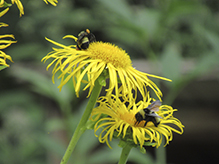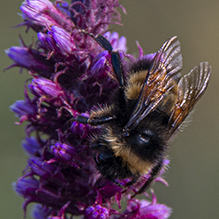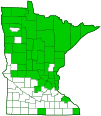yellow-banded bumble bee
(Bombus terricola)
Conservation • Description • Habitat • Ecology • Distribution • Taxonomy
Conservation Status |
|
|||||||
| IUCN Red List | VU - Vulnerable |
|||||||
| NatureServe | NU - Unrankable SNR - Unranked |
|||||||
| Minnesota | not listed Species in Greatest Conservation Need |
|||||||
Description |
||
Yellow-banded bumble bee is a medium-sized bee but a small bumble bee. It occurs in the United States in the east and the Upper Midwest, and in southern Canada. It was once widespread and common, but its numbers have seriously declined since 2003. It remains widespread but is now uncommon or rare throughout its range except in southeastern Yukon and southwestern Northwest Territories, where it is thought to be still common. It is rare in Wisconsin, where it is given the conservation status of critically imperiled. It is uncommon in Minnesota, where it is not assigned a conservation status. The female (worker) bee is ⅜″ to 9⁄16″ (9 to 14 mm) in length and stout, 3⁄16″ to ¼″ (5 to 7 mm) wide. The hairs on the top and back of the head are entirely black. There are two large compound eyes, one on each side of the head, and three small simple eyes (ocelli) in a triangular pattern at the top of the head between the compound eyes. The middle ocellus is larger than the the two lateral ones. The face is short and round. It is mostly black but there are yellowish hairs between the compound eyes. The antennae have 12 segments consisting of one basal segment (scape), one small connecting segment (pedicel), and ten more segments (flagellomeres). The scape is long, about half as long as the all of the flagellomeres together. The first flagellomere is slightly longer than the third. The second is about as long as wide. The third is slightly longer than the second. The space below the compound eye (malar space) is smooth and shiny. The tongue is short. The thorax is densely covered with relatively short hairs. It is always yellow in front of the wing pads (tegulae) and is usually entirely black behind the tegulae. Sometimes there is a yellowish band at the rear. The abdomen has six abdominal segments and is densely covered with short hairs. The first segment is black, the second and third yellow, and the fourth through sixth black. Some individuals have a yellow fringe on the fifth segment. The wings and legs are black. The queen is similar but larger. The male has seven abdominal segments; 13 antennae segments; and longer, shaggier hairs. The seventh abdominal segment has intermixed black and yellow hairs. |
||
Size |
||
Queen: ⅝″ to ¾″ (17 to 19 mm) Male: ½″ to ⅝″ (13 to 17 mm) Worker: ⅜″ to 9⁄16″ (9 to 14 mm) |
||
Similar Species |
||
Habitat |
||
A wide range of habitats, including woodlands and wetlands. |
||
Ecology |
||
Season |
||
Queens are seen from late April to early September, workers from mid-June to mid-September. |
||
Behavior |
||
Bumble bees will sting to protect themselves or their nest. The stinger is not barbed and the bee can sting multiple times. |
||
Life Cycle |
||
Overwintering queens emerge from hibernation in late April. They build underground nests. |
||
Larva Food |
||
Larvae are fed both nectar for carbohydrates and pollen for protein. |
||
Adult Food |
||
Adults feed mostly on nectar but also on some pollen. |
||
Distribution |
||||
|
Sources Records of yellow-banded bumble bee in western United States are thought to be mis-identifications of western bumble bee (Bombus occidentalis). |
|||
| 7/24/2023 | ||||
Occurrence |
||||
Uncommon in Minnesota |
||||
Taxonomy |
|||
Order |
Hymenoptera (Ants, Bees, Wasps, and Sawflies) | ||
Suborder |
Apocrita (Narrow-waisted Wasps, Ants, and Bees) | ||
Infraorder |
Aculeata (Ants, Bees, and Stinging Wasps) | ||
Superfamily |
Apoidea (Bees and Apoid Wasps) | ||
| Epifamily | Anthophila (bees) | ||
Family |
Apidae (honey bees, bumble bees, and allies) | ||
Subfamily |
Apinae (honey, bumble, longhorn, orchid, and digger bees) | ||
Tribe |
Bombini (bumble bees) | ||
Genus |
Bombus (bumble bees) | ||
Subgenus |
Bombus | ||
Synonyms |
|||
Bremus terricola Terrestribombus terricola |
|||
Common Names |
|||
yellow-banded bumble bee |
|||
Glossary
Flagellomere
A segment of the whip-like third section of an insect antenna (flagellum).
Malar space
In Hymenoptera, the space, equivalent to the cheek, between the bottom of the compound eye and the base of the mandible.
Ocellus
Simple eye; an eye with a single lens. Plural: ocelli.
Scape
In plants: An erect, leafless stalk growing from the rootstock and supporting a flower or a flower cluster. In insects: The basal segment of the antenna.
Tegula
A small, hardened, plate, scale, or flap-like structure that overlaps the base of the forewing of insects in the orders Lepidoptera, Hymenoptera, Diptera, and Homoptera. Plural: tegulae.
Minnesota Bumble Bee Identification Guide
The University of MN Bee Lab has a free field identification guide to Minnesota bumble bees. It is indispensable for amateur naturalists or anyone wanting to identify the bumble bee in their photo. Click on the image below to download the guide.
Visitor Photos |
|||||
Share your photo of this insect. |
|||||
| This button not working for you? Simply email us at info@MinnesotaSeasons.com. Attach one or more photos and, if you like, a caption. |
|||||
Margot Avey |
|||||
 |
|||||
MinnesotaSeasons.com Photos |
|||||
 |
|||||

Visitor Videos |
|||
Share your video of this insect. |
|||
| This button not working for you? Simply email us at info@MinnesotaSeasons.com. Attach a video, a YouTube link, or a cloud storage link. |
|||
Other Videos |
|||
| Bombus terricola - 2020/06/21 Bombus mystax |
|||
About
Jun 25, 2020 BBW #64786 |
|||
| Bombus terricola - 2019/07/31 Bombus mystax |
|||
About
May 24, 2020 Bombus terricola cleaning itself. |
|||
| Yellow-Banded Bumble Bee (Bombus terricola) warming up in the morning Ben Armstrong |
|||
About
Jul 7, 2020 The bee was sluggish (likely due to 15C temperature) and only began to move around after I had disturbed it. For iNaturalist observation: https://www.inaturalist.org/observations/52255796 |
|||
| Bombus terricola gathering pollen from coreopsis verticillata Elementi Foods |
|||
About
Apr 24, 201 Inspired by the Beecology Project I started observing native pollinators in the flowers around the house and in the garden. I was pleasantly surprised to find a native species of bee living in the neighborhood. Bombus terricola, like all of our native pollinators are in decline and we need to do our part to help. Doing our part is as simple as planting native flowering plants. Native plants are extremely low maintenance and easy to grow. |
|||

Visitor Sightings |
|||||
Report a sighting of this insect. |
|||||
| This button not working for you? Simply email us at info@MinnesotaSeasons.com. Be sure to include a location. |
|||||
| Margot Avey 7/8/2021 |
Location: Lake Harriet Trial Gardens in Minneapolis |
||||
MinnesotaSeasons.com Sightings |
|||||

Created: 8/4/2021
Last Updated:




